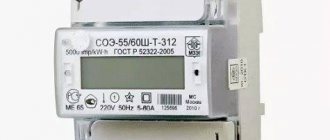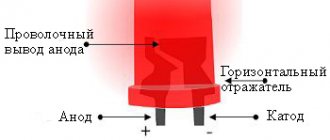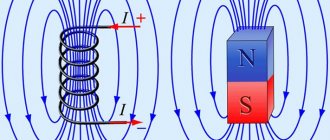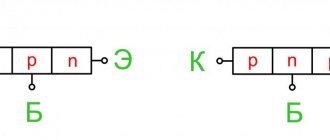The residual current device is used to protect a person from electric shock as a result of a leak. Today, these devices are produced in two versions: electronic or electromechanical. The former are more modern and also cost less, the latter, in turn, have been on the market longer and, most importantly, are more reliable in terms of protection (we’ll talk about this below). Next, we will tell you how to distinguish an electronic RCD from an electromechanical one and what is better to choose for home electrical wiring.
How to choose an RCD
Choosing an RCD for residential electrical wiring or home wiring is not difficult for a home electrician. Any single-phase RCD is suitable, designed for an operating current equal to the protection current of the circuit breaker and a leakage current of 30 mA
. A photograph of such an RCD is shown at the beginning of the article.
Which type of RCD is better for an apartment: electromechanical or electronic?
RCDs are produced in two designs - electromechanical and electronic. To make the right choice, you need to compare their technical characteristics.
| Comparative table of characteristics of electromechanical and electronic RCDs | ||
| Characteristic | Electromechanical RCD | Electronic RCD |
| Price | low | high |
| Design | complex | simple |
| Reliability | high | low |
| Operating current error | high | low |
| Operability in the event of a break in the neutral wire or when the network voltage drops below the permissible level | saved | does not work |
| Resistance to high voltage surges in the network | high | low |
| dimensions | big | many times less |
As can be seen from the table, if there are no restrictions on overall dimensions, you need to choose an electromechanical RCD. An electronic RCD is indispensable when installed on a separate electrical device, for example, in an electrical outlet or extension cord.
Main technical characteristics of RCD
Requirements for the technical characteristics of RCDs are established by GOST R 51326.1-99 (IEC 61008-1-96) “Automatic circuit breakers, controlled by differential current, for household and similar purposes without built-in overcurrent protection.”
For those who want to make a more informed choice, I have summarized all the main technical characteristics of the RCD in a table.
| Table of main technical characteristics of RCD | |||
| Characteristic | Designation | Magnitude | Note |
| Operating voltage | IN | 220, 380 | For a single-phase home network, an RCD is installed at a voltage of 220 V, for a three-phase network - at 380 V |
| Number of phases | 1, 3 | Indicated in the passport | |
| Operation leakage current, IΔn | mA | 5 | There are no installation instructions in the PUE, but they can be found in recommendations for the use of electrical appliances, for example, heated floors |
| 10 | Designed for connecting sockets installed in the bathroom, kitchen, children's rooms and for appliances installed on the ground | ||
| 30 | Universal, suitable for all applications in the house or apartment | ||
| 100, 300 | Used in industry, sometimes installed at the entrance of electrical wiring into housing to increase fire safety | ||
| Maximum load current, In | A | 6-125 | Must be equal to or greater than the current of the circuit breaker installed after the RCD |
| Maximum switching current, Im | A | 500 | Must be 10 times the maximum load current |
| Short Circuit Current, Inc | kA | 3-10 | The maximum current that the RCD will briefly withstand in the event of a short circuit in the electrical wiring |
| Shutdown time | ms | The time after which, after exceeding the permissible leakage current, the RCD must turn off the load | |
| Check frequency | month | 1 | For a simple test, just press the RCD Test button. To diagnose the response time, a special device is required |
| Working temperature | °C | minus 25 — +40 | Operating temperature at which RCD operation is allowed |
| Design | Electromechanical | More reliable, cheaper, but larger in size than electronic RCDs | |
| Electronic | Modern RCDs, expensive, small-sized | ||
| Type according to operating current shape | AC | Triggers if the sinusoidal leakage current increases slowly or abruptly | |
| A | Triggers if the sinusoidal or pulsating DC leakage current increases slowly or abruptly | ||
| IN | Triggers if the sinusoidal, pulsating DC or DC leakage current increases slowly or abruptly | ||
| Installation method | Designed for mounting on a DIN rail in a panel | Designed for installation in electrical panels of apartments and houses | |
| Built into a socket | Installed to protect a separate electrical appliance or, in the case of old electrical wiring, to eliminate false alarms from natural leakage currents | ||
| In the form of an adapter connected to an outlet | |||
| Extension Mounted |
Variety of types of automatic machines
Currently, they produce a huge number of types of automatic machines for every taste. To choose among them the best option for a specific electrical network, you need to have an idea of their classification according to functionality. This will make choosing a device much easier. By passing them through a sieve of several of the most important characteristics, you can greatly reduce the list of suitable devices.
By network type and leakage current
Differential circuit breakers according to the type of controlled electrical network are divided into single-phase with a voltage of 220 V and three-phase with a linear voltage of 380 V, respectively, divided into two-terminal circuits for single-phase and four-terminal circuits for three-phase networks.
Depending on the leakage current occurring in the controlled network, difavtomats, like RCDs, are divided into the following categories.
Is it necessary to install an RCD?
As the practice of operating modern electrical appliances shows, it is almost impossible to get an electric shock during their operation if basic safety rules are observed.
Typically, the most dangerous place in portable electrical appliances is the power cord. As a result of bending, especially at the exit point from the electrical appliance and the plug, it will fray over time and the insulation may be damaged. Therefore, before connecting an electrical appliance, it is imperative to check the integrity of the cord insulation.
Modern electrical wiring has an additional grounding wire, to which the metal housings of electrical appliances are connected via an electrical plug. Therefore, in the event of an insulation breakdown, the circuit breaker will trip.
In apartments of old construction, there is no grounding wire in the electrical wiring, but the insulation is already worn out and, as a result of leakage currents, the RCD may give false alarms and the RCD should not be installed.
In addition, the RCD is connected to the break of the phase and neutral wires, as a result, four additional connections appear, which reduces the reliability of the electrical wiring as a whole, since it is at the connection points that contact is most often broken.
Based on the foregoing, we can conclude that existing protective measures even without an RCD reliably protect a person from electric shock.
The only justified case, from my point of view, is the installation of an individual RCD on electrical appliances installed in rooms with electrically conductive floors with high humidity. Such rooms include, for example, a bathroom.
But I am sure that in the near future the rules of the PUE will oblige the installation of RCDs in household electrical wiring in new apartments and houses, and this is probably correct. If there is a chance to save the life of at least one person from electric shock, then you need to take it.
Electricians have one rule called the One Hand Rule. The essence of this rule is that when touching or holding an electrical appliance in one hand, it is unacceptable to touch grounded elements with the other hand - a water pipe or a central heating radiator.
Attention! Before any work with electrical wiring, to avoid electric shock, it is necessary to de-energize it. To do this, turn off the corresponding circuit breaker in the distribution panel and check the reliability of the shutdown using the phase indicator
Danger of current leakage
An RCD is needed to protect you from electrical leaks.
As a result of insulation failure, live parts may come into contact with metal casings of equipment or building structures.
This leads to undesirable consequences:
- Electrical injury to users.
- Fire.
In both cases, part of the charge leaves the circuit. This phenomenon is called current leakage.
Correct connection diagram for RCD and circuit breaker installation errors
Stable operation of the RCD in electrical applications is ensured by a suitable circuit. The main groups of product designations must comply with GOST. In the circuit, before installing the RCD, it is necessary to install the AB.
The connection is made according to schemes depending on the type of electrical line:
- Connection without grounding - for single-phase wiring, for three-phase wiring.
- With existing grounding - for the TN-CS, TN-S system, for a single-phase or three-phase network.
The circuit breaker and the RCD must work together in the power supply circuit. The machine is located in front of the protection device. Install the RCD in the electrical installation panel.
Installation errors lead to improper operation of the device.
The most common of them:
- Galvanic connection of the neutral protective and working neutral conductors in the area of the product. In this case, a difference appears, since part of the current will flow past the device along the grounding conductor, which will lead to a false operation of the device.
- The neutral working wire is used as the neutral protective conductor. Using also an external conductor for these purposes. These cases lead to incorrect operation of the RCD.
For general consumer protection, an introductory RCD is installed directly after the AV.
Criteria for correct selection
Rated current
The first thing you need to pay attention to is what current the device is designed for. To choose the right RCD for current, you must first decide for what purpose the product will be installed. If you want to protect a separate network element, for example, a washing machine, an electric floor heating system or a water heater (boiler), the value can be no higher than 16 A
For all electrical wiring in the apartment, you need to install the unit at least 32 A. To select the correct value, you first need to calculate the load from all connected electrical appliances and, based on the resulting amount, select the most suitable RCD model. Manufacturers usually indicate the rated current load on the case of modern equipment, so calculations should not be difficult.
Differential current
We have considered all the existing values, which range from 10 to 500 mA, now we will figure out which RCD is better to choose based on amperage in certain situations. Protection of a person from electric shock is provided by settings from 6 to 100 mA. At the same time, leaks above 30 mA will be felt by the human body. That is why it is better to choose a 10 mA model for children’s rooms and bathrooms, and 30 mA to protect sockets and lamps.
It should also be noted that each electrical appliance has a natural leakage current, which is indicated in the attached technical data sheet. When choosing an RCD based on leakage current, be sure to take into account the following rule: the sum of natural leakages should not exceed the rated value of the protective device by more than 30% (1/3). Otherwise, false positives will occur, which will cause a lot of trouble.
Product type
So, in simple words we explain the purpose of each type of RCD:
- AC - mainly used to protect electrical appliances at home when using both single-phase and three-phase networks. Such a product cannot protect household appliances with pulsating current, for example, a washing machine.
- A - is used specifically for separate protection of washing machines in apartments and private houses.
- B - mainly used in production, so there is no point in choosing this type for home.
- S - as we have already said, shutdown does not occur immediately when a leak is detected, but after a certain time setting. As a rule, it is used to prevent fire and is connected at the input panel, servicing all electrical wiring (therefore, the setting for the leakage current is selected at least 100 mA).
- G – mainly connected to a separate electrical device for control and timely fire protection. Unlike the “S” type, it has a shorter exposure time.
Design
There is nothing special to talk about here; electronic ones have a more complex operating principle and function only if there is a power source (external or mains power). Electromechanical ones are more reliable and durable, so it is better to choose an electromechanical RCD for an apartment or house, and the cost will be much lower.
Manufacturer
Well, the last, no less important criterion for choosing an RCD is based on the manufacturer. Today, the best companies in the production of these products are the following companies:
- Legrand;
- ABB;
- AEG;
- Schneider electric;
- Siemens;
- DEKraft.
Among budget models, the highest quality is from the companies Austro-UZO and DEK.
We recommend giving preference to more expensive products, but if the budget does not allow, domestic manufacturers will also cope well with protection. In any case, before purchasing, we advise you to visit electrical forums and read customer reviews about the chosen model! This way you will probably find out all the advantages and disadvantages of the product and determine exactly which RCD is better to choose.
Uzo electromechanical or electronic, how to distinguish and what is better to choose
Residual current switches (RCDs) are designed to cut off the voltage when a leakage current occurs, and modern or modernized wiring almost always contains this device in the electrical panel. But there are two types of RCD: electronic and electromechanical. In this article I will tell you how to distinguish them from each other and what is better to put in your home.
What is the difference between electronic and electromechanical RCDs
First, let's find out how they differ and on what principle they work. Let's start with the electromechanical one.
The main actuator of an electromechanical RCD is a differential transformer. Thus, in the event of a leakage, the current will pass through this transformer, and a current and voltage will also arise in the secondary winding of this transformer, which will cause the polarized relay, mechanically connected to the tripping mechanism, to operate. This will cause a shutdown.
And it turns out that regardless of whether there is voltage in the network at a given period of time or not, the electromechanical RCD will disconnect the damaged section of the network where the leakage current has arisen.
What about electronic?
And the electronic RCD will only work if there is a leakage current and the operating voltage is necessarily present in the network. Thus, if there is no power (the network is de-energized), then the electronic RCD will not work even if a leak occurs.
Here a completely logical statement arises: So what if it doesn’t work, there’s still no light!
This statement is not entirely true and now I will explain why.
Let's look at all possible emergency situations:
2. Break of the neutral wire. But this situation is much more dangerous and here’s why. Since there was a break in only one conductor, namely the working zero, the phase will still be present in the network. This means that electric shock is quite possible, and if at such a moment a breakdown of the washer’s insulation occurs, then when you touch it, you will be shocked, and the electronic RCD will be inactive, since there is no voltage, but only a dangerous potential.
3. The third very unpleasant moment is power surges. Because of them, electronic devices connected when a voltage surge occurs often fail. What is an electronic RCD? That's right, this device is constantly connected to the network. And a situation may well arise that the electronic board will fail and, because of this, the network will not be disconnected when a leakage current occurs.
It can be seen that the last two points in no way affect electromechanical RCDs, therefore, in my opinion, it is better to choose them for installation in your home.
So, we’ve decided on the type of RCD, now let’s learn how to distinguish them
How to distinguish electronic from electromechanical RCDs
The simplest and most accessible way to distinguish these products is to carefully examine the diagram that is drawn on all devices, because if you look closely at it you can find significant differences.
So, looking at the electromechanical RCD, you will see a differential transformer, it is connected through the secondary winding to a polarized relay, it also has a connection with the shutdown mechanism. As they say, mechanics in their purest form.
Now let's carefully study the circuit diagram of the electronic RCD
At first glance, the circuits are very similar, there is also a transformer and a relay, but in addition to these elements, this circuit contains one more, namely an electronic board to which power is supplied.
No power - no tripping of such an RCD.
We use a battery
Another option for determining which RCD is in front of you is to use any battery you have.
To do this, we take an RCD, a battery and two wires.
We clamp one ends of the wire to the RCD terminals
Then we turn on the RCD and touch the plus and minus ends of the battery. If nothing happens, then we swap the ends and lean against the battery again. Again, nothing happened - in front of you is an electronic RCD.
If the relay has worked (at least in one of the two options), then you have an electromechanical relay.
In these simple ways you can determine what type of relay is in front of you. And which one to choose, of course, is up to you, but I would install only an electromechanical RCD.
The article turned out to be useful and interesting, then thumbs up (like).
Thank you for your attention
Safety Basics
Work is carried out in compliance with the following rules:
- The line is de-energized and checked for absence of voltage with an indicator screwdriver. If the switch is located far from the installation site of the RCD, you should attach a sign on it with the text “People are working!” or place a watchman. To be safe, it is recommended to disconnect the wires from the terminals.
- When connecting wires, use only methods approved by the PUE: clamps, terminals, crimping with sleeves, welding. Soldering is not recommended; twisting is prohibited.
- The correct installation is checked by measuring the resistance of the phase-zero loop. A high indicator indicates poor contact in one of the connections. During operation, such places become hot and can cause a fire.
- Before applying voltage, protect eyes and exposed parts of the body. A low-quality product may fly apart.
- Do not use wires with insulation of the same color.
The difference between an electronic RCD and an electromechanical UDT
Electronic and electromechanical protection devices differ only in the type of threshold device. As noted above, electronic protection devices use an electronic amplifier as a threshold device, which generates a shutdown signal. This signal is sent to a conventional relay, which acts on a mechanical release. Electronic components, unlike electromechanical relays, are cheaper and have less technological variation. Therefore, an electronic RCD, as a rule, costs less than an electromechanical protection device.
People who have not previously encountered residual current devices often ask the question: how to distinguish an electromechanical RCD from an electronic one? Devices can be identified by markings on the front of the device. For all RCDs on the body you can see a symbolic image of a differential transformer. It is depicted as an ellipse enclosing power conductors. A symbolic communication line is drawn from the transformer going to the comparison device. The comparison device is depicted as a rectangle or triangle. If a triangle is drawn, then this is an electronic RCD. If the rectangle is an electromechanical device.
The eternal dispute about RCD
On electricians forums, debates continue on the topic: which protection device is better to use, electronic or electromechanical RCD?
In principle, there are no functional differences between devices with different threshold devices. Both types of differential current devices successfully perform their functions. But meticulous researchers have noticed one feature that the electronic RCD has. An op amp requires power to operate. It is taken from the input terminals of the protection device. Therefore, in the event of a break in the zero or phase supplying the electronic circuit, the device loses its functionality. An electromechanical RCD is free of this drawback, since the actuator is powered from the secondary winding of the transformer. Therefore, if the neutral wire breaks, the “electromechanics” will still work in the event of a phase leak.
Advantages and disadvantages of devices
It is convenient to compare the advantages and disadvantages of both types of protective devices in tabular form.
| Device Parameter | Electronic | Electromechanical |
| Price | higher | less |
| Design | simplified | complex |
| Sensitivity | increased | reduced |
| Operation when the “zero” is broken | No | Yes |
| Operation under significant voltage drop | No | Yes |
| Probability of failure due to surge voltages | higher | below |
As a result, it should be noted that the most suitable option for installation in a residential electric meter is still an electromechanical automatic circuit breaker or an RCD. This type of device is widely represented on the modern domestic market.
Rate the quality of the article:
According to the diagram on the RCD body
On the body of all modern RCDs its electrical circuit is depicted. If it is not on the front of the case, look at the top.
The electronic RCD circuit is somewhat different from the electromechanical circuit. If you know these differences, you can easily recognize the type of RCD before purchasing.
Electro-mechanical RCD diagram:
- differential transformer drawn
- a relay is drawn that is connected to a transformer
- disconnecting mechanism drawn
- the TEST button is still displayed
An example of such a scheme:
Electronic RCD diagram:
The elements that are depicted on the electronic RCD diagram are almost no different from those indicated on the electromechanical one. What's the difference? And it consists of an additional electronic board.
Two conductors are suitable for this element - phase and neutral, that is, 220V. This is the external power required for the operation of the electronic RCD.
Example of RCD operation
Let's give a small example of a typical RCD-D. Given:
- two-wire power supply circuit for 220 V, without grounding;
- as an energy consumer - a washing machine;
- switching device built into the circuit.
Normally, the RCD passes electricity directly and without obstacles. Incoming and outgoing currents are of equal importance. If, for example, an electric motor malfunctions, voltage will be applied to the body of the machine. By touching it, an unsuspecting person will be subjected to a powerful shock of electricity.
A leakage current and imbalance occurs: part of the energy flows through the body of the person under attack. Less electricity is returned to the RCD than was left, and the device breaks the circuit.
There are both simple mechanical protection devices and models with semiconductor contact breakers. There are also versions with more complex built-in logic. But electronic ones are more expensive and require additional power to maintain the operation of the circuits.
Electromechanical UDT device
Electromechanical RCDs consist of the following main parts:
- housings;
- contact system consisting of terminals to which power wires are connected, moving and fixed contacts used for switching;
- instrument transformer and rectifier;
- polarized relay;
- mechanical shutdown systems (release);
- electric arc extinguishing systems;
- test button and resistor.
Polarized relay
The executive element in electromechanical differential current devices is a polarized relay. A polarized relay belongs to the class of bistable DC relays. It can be either in the off or on state in the absence of voltage on its winding. In the RCD, the winding of the polarized relay receives rectified voltage from the measuring transformer. When the threshold value is reached, the relay switches, which is mechanically connected to the release. As a result, the UDT is turned off.
TEST button
Unlike circuit breakers and other protective devices, RCDs have the ability to check the functionality of the device. The test is performed by pressing the “Test” button. This button, together with a specially selected resistor, forms a chain that simulates the occurrence of leakage current. The ends of the chain are connected to the neutral and phase wires. The string conductors do not pass through the ring core of the differential transformer. Therefore, during the test, the balance of magnetic fluxes in the measuring system is disrupted. The resistor value is chosen so that the artificial leakage current is equal to the rated operating current of the differential protection.
Tags: automatic, ampere, boiler, sconce, type, water heater, choice, switch, house, , clamp, protective, sign, insulation, like, , magnet, installation, voltage, nominal, transfer, connection, constant, potential, rule, principle, wire, start, , work, size, calculation, resistor, relay, row, light, lamp, network, connection, circuit, ten, type, current, transformer, triangle, installation, phase, shield, electricity, electronic
Verification methods
The RCD is equipped with a Test button. After pressing it, the working device turns off. This method is intended to check the condition of the product, but not the correct connection. In the event of an error, a working RCD opens the circuit when the Test button is pressed, but may not respond to differential current.
To be 100% sure that the device is working, a controlled leak is performed. To do this, the phase is connected through a variable resistor and an ammeter to the ground or neutral conductor above the RCD. Only a licensed specialist has the right to perform such work.











